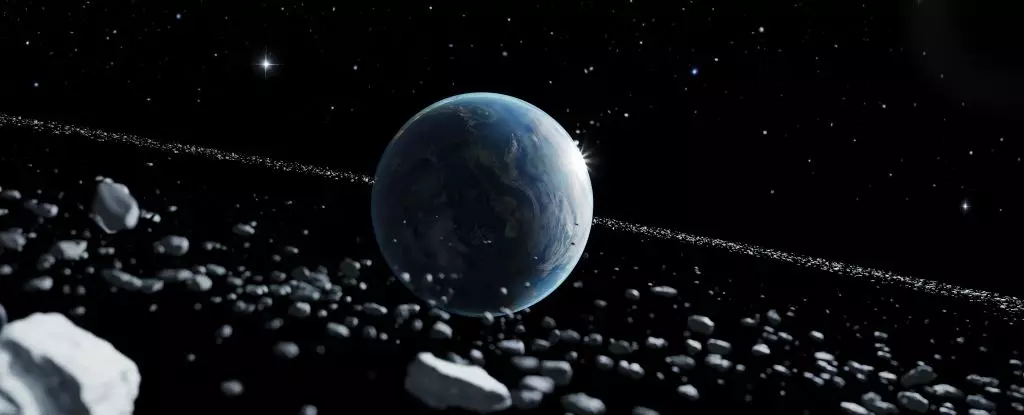Throughout Earth’s extensive history, a host of changes has sculpted its geological and climatic landscapes. One of the more intriguing hypotheses postulates that our planet may once have possessed its very own ring system, similar to those of the gas giants in our Solar System. This speculation emerges from a detailed investigation into unusual geological events, particularly the Ordovician impact spike, a significant uptick in meteorite impacts that occurred approximately 466 million years ago. The research, spearheaded by planetary scientist Andy Tomkins of Monash University, sheds light on how this short-lived but intense period created ripples in Earth’s geological record.
A ring, while faint and ephemeral, could account for a spike in meteorite bombardments during a specific geological epoch. The rock debris from a disintegrating asteroid could have formed a temporary orbit around Earth, which gradually decayed, raining down meteorites over tens of millions of years. The visual imagery conjured by this idea is captivating, evoking a vision of a vastly different Earth, adorned with a belt of cosmic rocks encircling its equator. Tomkins’ imaginative musings on what the Earth might have looked like during this time invite us to reconsider our planet’s dynamic past.
The Ordovician Impact Spike: A Brief Overview
The Ordovician period, falling within the Paleozoic era, was characterized by significant geological shifts and biodiversity. It spanned from around 485 million to 444 million years ago, and researchers have identified a distinct spike in meteorite impacts during this time, which lasted roughly 40 million years. Tomkins and his team analyzed 21 craters formed during this interval and uncovered a curious clustering phenomenon: these craters all fell within a narrow band around the equator, within 30 degrees latitude.
This localized concentration raises essential questions about the mechanisms behind such impacts. Unlike the random distribution expected from sporadic asteroid strikes, this unusual clustering hints at a coordinated source of meteorite debris. Instead of a haphazard barrage, the data suggests a systematic influx of material, leading to the hypothesis that Earth might have been encircled by a temporary ring, the remnants of a shattered asteroid. Such theories could illuminate gaps in our understanding of Earth’s geological history and the events that have shaped life.
Tomkins proposes a striking scenario where an asteroid, lured by Earth’s gravity, approached the planet closely enough to be torn apart by tidal forces. This process, known as crossing the Roche limit, allowed the asteroid’s fragments to enter stable orbits. These fragments were not simply abandoned debris; they coalesced into a ring-like structure that could have existed for millions of years before eventually succumbing to gravitational forces and atmospheric re-entry.
This hypothesis finds echoes in our observations of other celestial bodies. For instance, Saturn’s rings are known to be transient, with material spiraling into the planet at a high velocity. Similarly, the famous comet Shoemaker-Levy 9 met its fate with Jupiter, where the gravitational pull fragmented the comet into a field of debris that remained in orbit for a time. Such parallels bolster the plausibility of Earth having experienced a similar phenomenon during the Ordovician period.
Potential Climatic Effects of Earth’s Ring
While the implications of such a ring extend into fascinating realms, they also pose questions about climatic conditions during the Ordovician. A planetary ring could have substantially altered sunlight’s reach, casting shadows on Earth’s surface and potentially contributing to cooler climate episodes. According to Tomkins, this could have inadvertently led to significant climatic fluctuations and environmental challenges that might have driven rapid evolutionary changes in species, coinciding with the Great Ordovician Biodiversification Event.
Nevertheless, the need for further research remains critical. Numerical modeling is the next logical step for scientists, as it would simulate the breakup of an asteroid and the resultant formation of a hypothetical ring. Such studies could reveal insights into the potential dimensions and characteristics of the ring while helping us understand its impact on Earth’s climate.
As we continue to explore the enigmatic concept of a ringed Earth, it opens up whimsical thoughts about terraforming other planets. Tomkins speculates that redirecting a large asteroid into orbit around a hostile planet like Venus could echo past Earth scenarios, where the created ring would possibly lead to lower surface temperatures and more hospitable conditions over time.
While the prospect of terraforming celestial bodies remains firmly in the realm of science fiction, the exploration of Earth’s potential past ignites an enduring curiosity about our planet’s history and the cosmic narrative it inhabits. Imagining the once-ringed Earth not only challenges our understanding of planetary evolution but also serves as a reminder of the incredible dynamism of the cosmos, which continues to shape our world in ways we are only beginning to unravel.


Leave a Reply